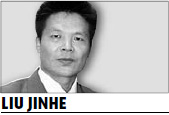

As a result of the government's easing of monetary policy to counter the global financial crisis, the scale of new loans was increased by another 1.5 trillion yuan in June following a continued increase totaling 5.8 trillion yuan from January to May.

However, whether the expansion will be able to continue is under scrutiny as the policy has had a limited effect on the real economy.
The free capital in the market has already been saturated resulting in the overheating of the financial and real estate markets, as well as overproduction and the development of a financial bubble.
A readjustment of the current policy is needed, because an excessive expansion of loans in a short period of time can only fuel the continued uncertainty of an economic recovery and industrial reconstruction.
According to statistics from the People's Bank of China, the scale of yuan loans by financial institutions during the first half of 2009 exceeded the annual target of 5 trillion yuan to total 7.3 trillion yuan.
The balance of broad money "M2" by the end of June 2009 was 56.2 trillion yuan, an increase of 28.5 percent from the previous year.
The total represented a 10.6 percent increase from the end of 2008 and 2.7 percent increase from the previous month.
An increase in market liquidity will lead to the speedy recovery of both stock and real estate markets
China's stagnant 'A' stock exchange price index stock has risen more than 60 percent in the last six months, exceeding a daily turnover of 200 billion yuan.
And due to the revitalization of the real estate industry in major cities such as Beijing and Shanghai, the price of land and housing has gone up to the same level as it was in 2007 -- when it was at its peak.
However, despite the encouraging state of the stock and real estate markets, most small to mid-sized businesses continue to face financial difficulties, as they are not considered desirable candidates for government loans.
Instead, the majority of funds is being concentrated in supporting large government-owned businesses, which is causing an increasing drift between the "sufficient funds" of government-owned businesses and the "insufficient funds" of small to mid-sized businesses.
The government's loan easing policies produced some negative effects on certain parts of China's economy.
Considering that the main culprit behind the slowdown of the Chinese real economy was its fragile economic structure, it would be difficult for China to recover its economy through the expansion of loans.
During the course of China's economic growth, disparities in investment and foreign and domestic demands began to appear. These disparities have yet to be resolved.
The majority of export-driven businesses in China, which has a 70 percent dependence rate on overseas trade, attempted to use the domestic market to resolve the excess in export production capabilities.
However, these companies faced limitations due to the nation's weak domestic consumption power.
There is a growing possibility that the loan-easing policy will result in deflation and overproduction, rather than an increase in consumption, due to the fact that a large amount of the funds are being injected into leading government-owned industries such as steel, cement and electricity.
The possibility of a financial bubble is slowly fading due to the large inflow of loans into the stock and real estate markets rather than the real economy.
Twenty percent of loan funds were invested into the stock and real estate markets in the first half of 2009, which is why the stock and real estate markets continued to do relatively well despite the economic slump.
Due to the government's dependence on capital from land and its contribution to economic growth, the government has more or less resigned itself to the abnormal swelling of the real estate industry.
And expectations of inflation are slowly increasing because large-scale loans have been excessively pumped into production.
Basic conditions of the monetary policy will be maintained and monetary easing will be adjusted according to the rate of economic recovery.
The monetary-easing policy will remain the same into the third quarter as tightening monetary policies in order to attain the 8 percent target economic growth rate, which will entail too much risk.
And with the growth rate of the first and second quarter being 6.1 percent and 7.9 percent, respectively, if the current monetary easing policy is sustained, an 8 percent growth rate or more in the third quarter is a real possibility.
If reaching the economic growth rate target goes according to plan, there will be no need to reduce the size of loans.
With the recovery of both domestic and foreign economies, a readjustment of the scale of loans will be needed from the fourth quarter.
It will also be necessary to re-examine the transfer path of funds in the real economy as well as preventing another financial crisis caused by a financial bubble through tightening, supervising and managing the funds being injected into the stock and real estate markets.
Approving loans to small and mid-sized businesses will help control the unemployment rate.
Currently, the adjustment of the central bank's monetary policy will depend on whether the bank decides on a continuous easing or fixed tightening policy.
An official at the central bank expressed his concerns about the two, saying that a tightening of loans could become an obstacle for economic recovery and that continuously easing them could lead to inflation.
The author is a researcher with Samsung Economic Research Institute (China). The views expressed here are his own.
(China Daily 09/07/2009 page2)













